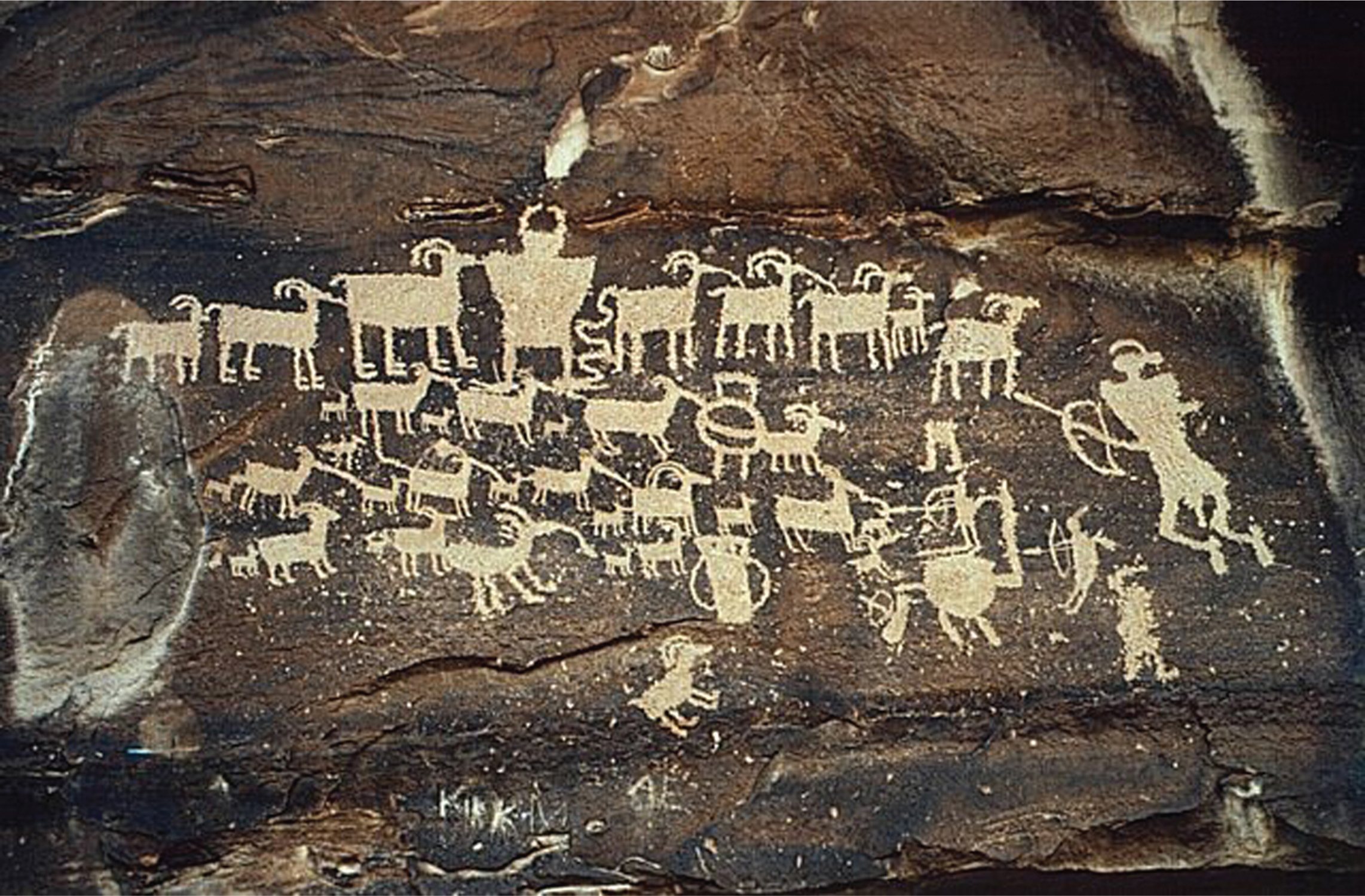The American Promise:
Printed Page 11
The American Promise Value
Edition: Printed Page 11
Chapter Chronology
Southwestern Cultures
Ancient Americans in present-day Arizona, New Mexico, and southern portions of Utah and Colorado developed cultures characterized by agricultural settlements and multiunit dwellings called pueblos. All southwestern peoples confronted the challenge of a dry climate and unpredictable fluctuations in rainfall that made the supply of wild plant food very unreliable. These ancient Americans probably adopted agriculture in response to this basic environmental uncertainty.
About 3500 BP, southwestern hunters and gatherers began to cultivate corn, their signature food crop. (See “Beyond America’s Borders.”) The demands of corn cultivation encouraged hunter-gatherers to restrict their migratory habits in order to tend the crop. A vital consideration was access to water. Southwestern Indians became irrigation experts, conserving water from streams, springs, and rainfall and distributing it to thirsty crops.

VISUAL ACTIVITY Ancient Agriculture Dropping seeds into holes punched in cleared ground by a pointed stick known as a “dibble,” this ancient American farmer sows a new crop while previously planted seeds—including the corn and beans immediately opposite him—bear fruit for harvest. Created by a sixteenth-century European artist, the drawing misrepresents who did the agricultural work in many ancient American cultures—namely, women rather than men. The Pierpont Morgan Library/Art Resource, NY. READING THE IMAGE: In what ways has this ancient farmer modified and taken advantage of the natural environment? CONNECTIONS: What were the advantages and disadvantages of agriculture compared to hunting and gathering?

VISUAL ACTIVITY Ancient Petroglyph More than a thousand years ago one or more members of the Fremont people crafted this hunting scene on a sandstone surface in Cottonwood Canyon in northeastern Utah. Four hunters aim their arrows into a flock of big horn sheep. Other human-like forms appear in the image—perhaps shamans or decoys to move the flock toward the hunters. Cave Art Gallery/Getty Images. READING THE IMAGE: What techniques might have allowed the hunters to concentrate the flock in the way depicted? CONNECTIONS: What weapons did earlier Paleo-Indians and Archaic Indians use for killing and capturing game?

Mexican Ball Court Model The Mexica and other Mesoamerican peoples commonly built special courts (or playing fields) for their intensely competitive ball games. This rare model of a Mexican ball court, made between 2200 BP and AD 250, shows a game in progress, complete with players and spectators. A few ball courts have been excavated in North America, compelling evidence of the many connections to Mexico. Yale University Art Gallery, Stephen Carlton Clark, B.A. 1903, Fund. 1973.88.26/Art Resource, NY.
About AD 200, small farming settlements began to appear throughout southern New Mexico, marking the emergence of the Mogollon culture. Typically, a Mogollon settlement included a dozen pit houses, each made by digging out a pit about fifteen feet in diameter and a foot or two deep and then erecting poles to support a roof of branches or dirt. Larger villages usually had one or two bigger pit houses that may have been the predecessors of the circular kivas, the ceremonial rooms that became a characteristic of nearly all southwestern settlements. About AD 900, Mogollon culture began to decline, for reasons that remain obscure.
Around AD 500, while the Mogollon culture prevailed in New Mexico, other ancient people migrated from Mexico to southern Arizona and established the distinctive Hohokam culture. Hohokam settlements used sophisticated grids of irrigation canals to plant and harvest crops twice a year. Hohokam settlements reflected Mexican cultural practices that northbound migrants brought with them, including the building of sizable platform mounds and ball courts. About AD 1400, Hohokam culture declined for reasons that remain a mystery, although the rising salinity of the soil brought about by centuries of irrigation probably caused declining crop yields and growing food shortages.
North of the Hohokam and Mogollon cultures, in a region that encompassed southern Utah and Colorado and northern Arizona and New Mexico, the Anasazi culture began to flourish about AD 100. The early Anasazi built pit houses on mesa tops and used irrigation much as their neighbors did to the south. Beginning around AD 1000, some Anasazi began to move to large, multistory cliff dwellings whose spectacular ruins still exist at Mesa Verde, Colorado, and elsewhere. Other Anasazi communities—like the one known as Pueblo Bonito whose impressive ruins can be visited at Chaco Canyon, New Mexico—erected huge stone-walled pueblos with enough rooms to house everyone in the settlement. (See “Visualizing History.”) Anasazi pueblos and cliff dwellings typically included one or more kivas used for secret ceremonies, restricted to men, that sought to communicate with the supernatural world. The alignment of Chaco buildings with solar and lunar events (such as the summer and winter solstices) also suggest that the Anasazi studied the sky carefully, probably because they believed supernatural celestial powers influenced their lives in every way. Pueblo Bonito stood at the center of thousands of smaller pueblos that sent food and other goods to support Bonito’s spiritual and political elites. Exactly how the Pueblo Bonito elites exercised power over the satellite pueblos is not known, but it probably involved a combination of violence and spiritual ceremonies performed in the kivas. Drought began to plague the region about AD 1130, and it lasted for more than half a century, triggering the disappearance of the Anasazi culture. By AD 1200, the large Anasazi pueblos had been abandoned. The prolonged drought probably intensified conflict among the pueblos and made it impossible to depend on the techniques of irrigated agriculture that had worked for centuries. Some Anasazi migrated toward regions with more reliable rainfall and settled in Hopi, Zuñi, and Acoma pueblos that their descendants in Arizona and New Mexico have occupied ever since.


